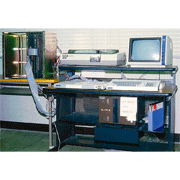There was a productive age of research at Kobe University that led to the design and implementation of a Lisp machine, led primarily by Taki Kazuo and Kaneda Yukio, and a Prolog machine, led primarily by Wada Koichi and Tamura Naoyuki. The Lisp machine was developed in the second half of the 1970s. This was followed by the Prolog machine called PEK (standing for "Prolog Engine of Kobe University"). PEK was influenced by the Fifth Generation Computer Systems project (a Ministry of International Trade and Industry initiative), and its design was started in 1983. The objective was to create a specialized computer that would run Prolog programs at high speeds. The machine was finished in May 1984. In addition to running Prolog programs, PEK was used in processing systems that compiled Prolog into microcode. The completed machine had an execution speed of about 60,000 LIPS (logical inferences per second).
PEK's concept was to reach high execution speeds with the following design policies.
- Write the Prolog interpreter in microcode
- In essence, incorporate parallel execution wherever possible, even in sequential execution stages
- Use a common architecture
- Add specialized hardware
In general, PEK was connected to a MC-68000 host processor, and programs were converted to an internal format by the host processor before being stored in shared memory. When a goal statement was entered, PEK would be launched.
Compiled from pp.196-197, "The History of Japanese Computers", edited by the Special Committee for the History of Computing, IPSJ. Ohmsha, 2010.


